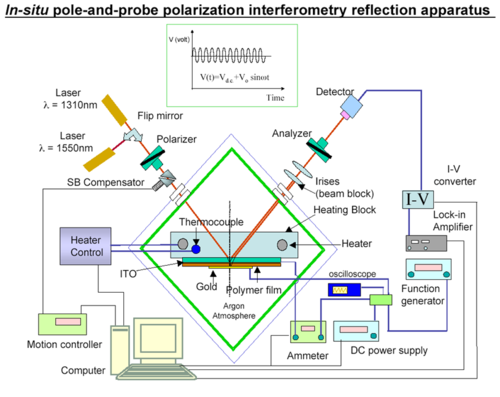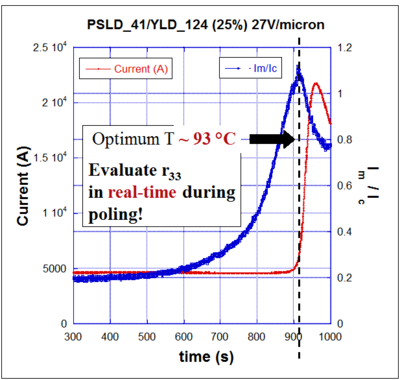Difference between revisions of "Teng-Man Method"
Cmditradmin (talk | contribs) |
|||
| (14 intermediate revisions by 2 users not shown) | |||
| Line 2: | Line 2: | ||
<tr> | <tr> | ||
<td style="text-align: center; width: 33%">[[Main_Page#Research Equipment, Devices and Techniques|Return to Research Tool Menu]]</td> | <td style="text-align: center; width: 33%">[[Main_Page#Research Equipment, Devices and Techniques|Return to Research Tool Menu]]</td> | ||
=== Teng- | === Teng-Man Method for Measuring Electro-optic coefficient=== | ||
[[Image:teng_mann.png|thumb|500px|Teng-Man Testing configuration]] | [[Image:teng_mann.png|thumb|500px|Teng-Man Testing configuration]] | ||
The Teng - Man method can measure R<sub>33</sub> as the sample is being poled. | The Teng - Man method can measure R<sub>33</sub> as the sample is being poled. | ||
R<sub>33</sub> is an elipsometric measurement<ref>http://en.wikipedia.org/wiki/Ellipsometry</ref>. A poling voltage is applied to the film while making the elipsometric measurements and looking for changes in the AC signal generated by incident light. The stage can be heated until the film reaches its melting point T<sub>g</sub>. These measurements are made with the materials in a device configuration. The formula for R<sub>33</sub> | R<sub>33</sub> is an elipsometric measurement<ref>http://en.wikipedia.org/wiki/Ellipsometry</ref><ref>SIMPLE REFLECTION TECHNIQUE FOR MEASURING THE ELECTRO-OPTIC COEFFICIENT OF POLED POLYMERS Teng CC, Man, HT APPLIED PHYSICS LETTERS Volume: 56 Issue: 18 Pages: 1734-1736 DOI: 10.1063/1.103107</ref> . A poling voltage is applied to the film while making the elipsometric measurements and looking for changes in the AC signal generated by incident light. The stage can be heated until the film reaches its melting point T<sub>g</sub>. These measurements are made with the materials in a device configuration. The formula for R<sub>33</sub> | ||
:<math>r_{33}= \frac {3\lambda I_m } {4 \pi V_{poly}I_c n^2 } \frac {(n^2 - sin^2 \theta) ^{1/2}}{sin^2 \theta} \approx I_m/ I_c | :<math>r_{33}= \frac {3\lambda I_m } {4 \pi V_{poly}I_c n^2 } \frac {(n^2 - sin^2 \theta) ^{1/2}}{sin^2 \theta} \approx I_m/ I_c | ||
| Line 31: | Line 31: | ||
[[Image:Teng mann graph.png|thumb|400px|right|Real time optimization of r<sub>33</sub>]] | [[Image:Teng mann graph.png|thumb|400px|right|Real time optimization of r<sub>33</sub>]] | ||
Teng-Man techniques allows real-time optimization of processing conditions because you can evaluate r<sub>33</sub> during the poling process. It is used to confirm that a sample has been poled. The R33 measurement is best used as a relative measure because it can be inaccurate. Use attenuated total reflection ATR to get an accurate absolute measure. | |||
| Line 41: | Line 41: | ||
=== Technique === | === Technique === | ||
{{#ev:youtube|FjjnY77ypNc}} | |||
{{#ev:youtube| | |||
=== Significance === | === Significance === | ||
Latest revision as of 16:40, 2 November 2016
Teng-Man Method for Measuring Electro-optic coefficient
The Teng - Man method can measure R33 as the sample is being poled. R33 is an elipsometric measurement[1][2] . A poling voltage is applied to the film while making the elipsometric measurements and looking for changes in the AC signal generated by incident light. The stage can be heated until the film reaches its melting point Tg. These measurements are made with the materials in a device configuration. The formula for R33
- <math>r_{33}= \frac {3\lambda I_m } {4 \pi V_{poly}I_c n^2 } \frac {(n^2 - sin^2 \theta) ^{1/2}}{sin^2 \theta} \approx I_m/ I_c
\,\!</math> where
- <math>I_m\,\!</math> is the amplitude of modulation
- <math>V_{poly}\,\!</math> is the modulation voltage across EO polymer
- <math>I_c\,\!</math> is the half intensity point
- <math>n\,\!</math> is the refractive index of the polymer
and
- <math>V_{poly}= V_{ACtot} \frac {d_{poly}} {d_{poly} + d_{clad}} \cdot \sqrt {\frac {\epsilon_{clad}} {\epsilon _{poly}}}\,\!</math>
The measured quanitities are:
- <math>I= 2I_M\,\!</math> Modulated Intensity
- <math>I_0 = 2I_C\,\!</math> Output intensity
- <math>V_m = V_0 sin\omega t\,\!</math> Modulation Voltage
Teng-Man techniques allows real-time optimization of processing conditions because you can evaluate r33 during the poling process. It is used to confirm that a sample has been poled. The R33 measurement is best used as a relative measure because it can be inaccurate. Use attenuated total reflection ATR to get an accurate absolute measure.
See Khanarian 1996 [3]
See STC-MDITR research project 1.1 [4]
Technique
Significance
References
- ↑ http://en.wikipedia.org/wiki/Ellipsometry
- ↑ SIMPLE REFLECTION TECHNIQUE FOR MEASURING THE ELECTRO-OPTIC COEFFICIENT OF POLED POLYMERS Teng CC, Man, HT APPLIED PHYSICS LETTERS Volume: 56 Issue: 18 Pages: 1734-1736 DOI: 10.1063/1.103107
- ↑ Khanarian, et. al., JOSA B13, 1927 (1996)
- ↑ http://stc-mditr.org/research/oeoaomd/projects/1.111.cfm Measuring R33 with Interferometry
| Return to Research Tool Menu |


